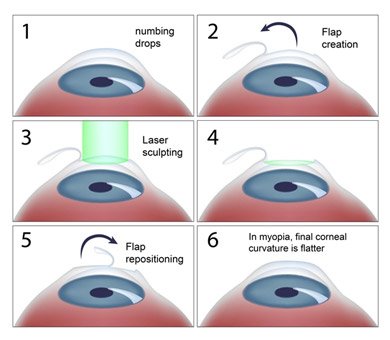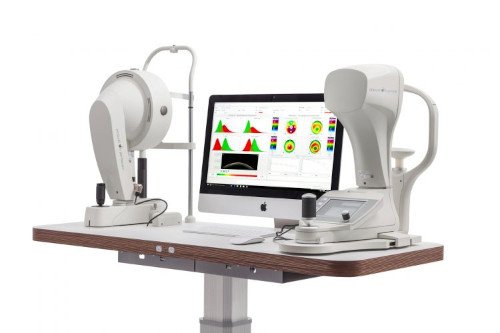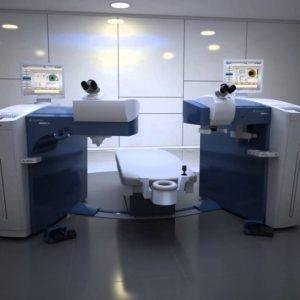What is LASIK (LASER -Assisted in situ keratomileuses)?

Lasik is a painless day-care procedure to correct the eyesight and do away with the cumbersome spectacles (glasses) and contact lenses, boosting the self-image and confidence of patients. Medically, LASIK surgery rectifies the refractive errors (like long-sightedness, near-sightedness, and astigmatism). In this procedure, the doctor corrects the vision with excimer LASERS.
Let us first understand how we see. In a person with normal vision or eyesight, the light rays pass through the cornea, pupil, lens and then focus on the retina (inner layer of the eye). This process of light refraction facilitates a clear, near and distant vision.
When the light rays fail to fall on the retina, we term it as a refractive error. It leads to imperfection in eyesight. Either one cannot see distant objects or have difficulty in seeing clearly near objects.
When the light falls in front of the retina, we have difficulty seeing distant objects. This eyesight problem is Myopia or short sight. Minus number glasses are prescribed to correct it.
When the light rays fall on the back of the retina, near objects are not visible with clarity. This vision error is referred to as hypermetropia or long-sightedness and corrected with the use of plus number glasses or lens.
Another eyesight issue is astigmatism, in which case the light rays are focused at different points on the retina resulting in blurred or distorted vision.
In recent years, since the advent of LASER technology in medicine, eye treatments have been revolutionized. LASIK is one such treatment. It corrects the focusing power of the eye, and a person needs no glasses or lenses.
LASIK is a precise, safe, and hassle-free day-care procedure.
Talk to an eye doctor to check if you are eligible for this innovative procedure.
At Maa Nursing Home and NetraJyoti Eyecare Centre, we have a dedicated LASIK clinic and have successfully operated upon thousands of patients and helped them get rid of their glasses and lenses. We offer Contoura as well as Bladeless LASIK surgery.
LASIK Surgery done by Dr Jugal Shah
Can anyone get a LASIK done?
No. For the LASIK procedure, there are certain eligibility conditions to be met. You are eligible for LASIK if you:
- Are above 18 years of age
- Have no fluctuations in the hormonal levels (Diabetes, pregnancy)
- Have stable refractive error (number of glasses) for last six months
Remember, the LASIK technique can correct Myopia up to 18.0D, hypermetropia from +1.0D to 6.0D and Astigmatism from -1.0 D to 6.0D.

What are the diagnostic tests done before the LASIK procedure?
- Routine eye examination
- Keratometry – To evaluate the shape of the cornea
- Pachymetry – To measure the thickness of the cornea.
Your eye doctor will measure your cornea, noting the shape, contour, thickness, and any irregularities. And will evaluate which areas of your cornea need reshaping and determine the precise amount of tissue to remove from your cornea.
Who should avoid LASIK?
LASIK surgery is usually not advisable if you:
- Have an eye disease that causes the cornea to thin and bulge, or if you have a family history of it
- Have a good overall vision
- Have severe near-sightedness
- Have extra-large pupils or thin corneas
- Have age-related eye changes that cause vision to be less clear
- Participate in contact sports that may be associated with blows on the face

How is LASIK done?
The cornea is a crystal-like dome that covers the front of the eye. The cornea accomplishes the majority (70%) of the bending light rays. LASIK procedure uses a computer-controlled “Excimer LASER” to shape the cornea to correct the refractive error.
The excimer LASER is an ultraviolet LASER and utilizes gas (Argon and Fluorine) to create a non-thermal cool beam of LASER light.
The procedure takes place under local anaesthetic drops that help to numb the cornea. We do not give any injections. This procedure is safe and painless, albeit with some discomfort.
The doctor places a ring on the eye and applies pressure to create suction. As the suction ring is on, vision dims, and the patient may feel slight discomfort. Then with a microkeratome, the corneal flap is cut. The flap is then lifted and folded back on the hinge to dry the exposed tissue. The laser beam is then focused, and the patient stares at a particular red light. This light helps to keep the eye steady on one spot. Your eye surgeon uses a small blade or cutting laser to cut a small, hinged flap away from the front of your eye. Folding back the flap allows your doctor to access that part of your cornea to reshape.
The doctor uses a programmed LASER to scoop out a tiny part of your cornea with each pulse of the LASER beam. With the help of computer controls, the amount of laser energy delivered to the patient’s eye is increased or decreased as needed, to correct the refractive curvature. Once done, the corneal flap is set back in its position. There is no need for any stitch, it bonds naturally. No eye patch is put after LASIK. This procedure is safe and painless, albeit with some discomfort.
At Maa Nursing Home and NetraJyoti Eyecare Centre LASIK procedure is done with two methods.

- LASIK- Contoura, where the doctor cuts the flap manually.
- Bladeless LASIK where the doctor cuts the flap using Femto Second machine
LASIK surgery takes about 15-20 minutes, and a patient can go home after the procedure. There is no hospitalization. Both eyes can be operated simultaneously in one sitting.
LASIK eye surgery is very popular with youngsters and is the best known and most performed LASER refractive surgery to correct vision problems.
Glasses or contact lenses can correct vision but reshaping the cornea itself solves the root cause of the problem.
What are the risks of LASIK surgery?
Although a safe procedure, some patients may experience the following symptoms for a few days or weeks:
- Dry eyes for which your doctor will prescribe eye drops.
- Increased sensitivity to light, glares, halos, and double vision
There are a few risks in LASIK surgery. Your doctor will explain the pros and cons of the surgery.
Complications that result in a loss of vision are rare.
What are the precautions to be taken before and after the surgery?
Before the surgery:
- The doctor will recommend discontinuing wearing your soft contact lenses for at least 48 -72 hours
- If you are wearing an RGP lens, discontinue wearing for 15 days
On the day of surgery:
- Wash your hair
- No eye cosmetics to be applied
- Do not wear cream, lotions, perfumes, deodorant etc.
After the surgery:
- Wear sunglasses for up to 1 week
- No splashing of water directly into the eye for around one
month
- No head bath for one week
- No swimming for one month.
How long does it take to recover post-surgery?
Results indicate that vision stabilizes in 2 weeks after the LASIK procedure. You can get back to work within 2-3 days of treatment.